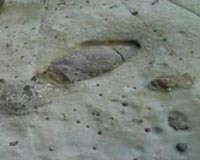| . |  |
. |
London, UK (SPX) Jul 22, 2009 A new study published this week takes scientists a step further in their quest to understand how Antarctica's vast glaciers will contribute to future sea-level rise. Reporting in the journal Nature Geoscience, scientists from British Antarctic Survey (BAS) and University of Durham describe how a new 3-d map created from radar measurements reveals features in the landscape beneath a vast river of ice, ten times wider than the Rhine*, in the West Antarctic Ice Sheet. During 2007, two researchers spent months living and working on the Rutford Ice Stream in temperatures that dropped as low as -30 degrees C. The ice stream moves towards Antarctica's coast by one metre every day. The science team towed radar equipment back and forth across the ice measuring its thickness, and building up a picture of the landscape beneath. A lubricating mixture of sediment and water beneath the ice assists as it flows towards the ocean, and is sculpted into a series of massive ridges the size of tower blocks and separated by deep furrows. These features ultimately control the flow of the ice stream. Lead author British Antarctic Survey glaciologist Edward King says, "It was really exciting to see this beautiful image of the landscape two kilometers below our feet emerge from the data. We are now sure that these amazing sediment formations are created by fast-flowing ice and we are much better placed to understand how ice streams behave and how they might change in the future." Co-author Dr Chris Stokes from University of Durham has studied similar features in parts of northern Canada which were covered by glaciers 9000 years ago. He says, "It's interesting to note that the features we see in Canada are the same as those under the Rutford Ice Stream. Until now we could only guess how they were formed. The next step will be to look closer at these features in Canada to see what happened as the glaciers disappeared." British Antarctic Survey scientists have measured the movement and behaviour of the Rutford Ice Stream for the last 25 years. Technological developments in the past 13 years, including satellites, seismic studies and radar, has led to a much greater understanding of what lies beneath Antarctica's vast ice sheet. There is still much to learn, but the techniques developed for the study will greatly improve scientists' capability to measure how the ice sheet may change in the future. Share This Article With Planet Earth
Related Links British Antarctic Survey Beyond the Ice Age
 Did dinos burrow to survive harsh climate?
Did dinos burrow to survive harsh climate?Atlanta (UPI) Jul 12, 2009 Dinosaurs of different species in different hemispheres -- millions of years apart -- burrowed, perhaps to survive, an Emory University paleontologist says. Anthony Martin, the paleontologist, and other researchers had discovered 95-million-year-old skeletal remains of dinosaurs in a fossilized burrow in southwestern Montana in 2006. The researchers said the find suggested burrow ... read more |
|
| The content herein, unless otherwise known to be public domain, are Copyright 1995-2009 - SpaceDaily. AFP and UPI Wire Stories are copyright Agence France-Presse and United Press International. ESA Portal Reports are copyright European Space Agency. All NASA sourced material is public domain. Additional copyrights may apply in whole or part to other bona fide parties. Advertising does not imply endorsement,agreement or approval of any opinions, statements or information provided by SpaceDaily on any Web page published or hosted by SpaceDaily. Privacy Statement |